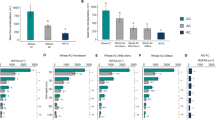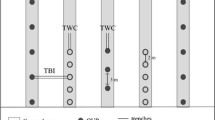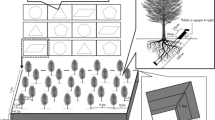Abstract
Aims
We investigated whether tree species growing in mixtures and under different water supply would segregate their fine roots vertically, produce more fine roots overall, or only in specific soil layers.
Methods
We examined the biomass, morphology, and distribution of fine roots down to 90 cm (forest floor, 0–5, 5–15, 15–30, 30–60, 60–90 cm) in pure and mixed stands of 10-year-old birch and pine trees, planted on a sandy podzol with discontinuous hardpan and seasonal high water table, following a randomized block design with four blocks receiving irrigation and four blocks left unirrigated during summer.
Results
Our results did not show any vertical root segregation between birch and pine in mixed plots. None of the species overyielded belowground throughout, but pine developed more roots in the top soil layer under irrigation. Both species had shallower fine root distributions in wet conditions, especially birch that was more plastic than pine in response to irrigation.
Conclusions
Both species followed similar ecological strategies, occupying and competing for the same layers of the soil profile, under both control and irrigated conditions. However, the greater allocation of pine roots at the top soil horizons under irrigated conditions suggests locally favourable niches can lead to depth-specific asymmetric competition. This sheds new light on vertical niche partitioning of young tree mixtures under varying environmental conditions.




Similar content being viewed by others
Change history
18 December 2020
A Correction to this paper has been published: https://doi.org/10.1007/s11104-020-04801-z
References
Achat DL, Bakker MR, Trichet P (2008) Rooting patterns and fine root biomass of Pinus pinaster assessed by trench wall and core methods. J For Res 13:165–175. https://doi.org/10.1007/s10310-008-0071-y
Agerer R (2001) Exploration types of ectomycorrhizae: a proposal to classify ectomycorrhizal mycelial systems according to their patterns of differentiation and putative ecological importance. Mycorrhiza 11:107–114. https://doi.org/10.1007/s005720100108
Augusto L, Bakker MR, Morel C, Meredieu C, Trichet P, Badeau V, Arrouays D, Plassard C, Achat DL, Gallet-Budynek A, Merzeau D, Canteloup D, Najar M, Ranger J (2010) Is “grey literature” a reliable source of data to characterize soils at the scale of a region? A case study in a maritime pine forest in southwestern France. Eur J Soil Sci 61:807–822. https://doi.org/10.1111/j.1365-2389.2010.01286.x
Bakker MR, Augusto L, Achat DL (2006) Fine root distribution of trees and understory in mature stands of maritime pine (Pinus pinaster) on dry and humid sites. Plant Soil 286:37–51. https://doi.org/10.1007/s11104-006-9024-4
Bakker MR, Jolicoeur E, Trichet P, Augusto L, Plassard C, Guinberteau J, Loustau D (2009) Adaptation of fine roots to annual fertilization and irrigation in a 13-year-old Pinus pinaster stand. Tree Physiol 29:229–238. https://doi.org/10.1093/treephys/tpn020
Barry KE, Mommer L, van Ruijven J, Wirth C, Wright AJ, Bai Y, Connolly J, de Deyn GB, de Kroon H, Isbell F, Milcu A, Roscher C, Scherer-Lorenzen M, Schmid B, Weigelt A (2019) The future of complementarity: disentangling causes from consequences. Trends Ecol Evol 34:167–180. https://doi.org/10.1016/j.tree.2018.10.013
Barry KE, van Ruijven J, Mommer L et al (2020) Limited evidence for spatial resource partitioning across temperate grassland biodiversity experiments. Ecology 101:1–13. https://doi.org/10.1002/ecy.2905
Bauhus J, Messier C (1999) Soil exploitation strategies of fine roots in different tree species of the southern boreal forest of eastern Canada. Can J For Res 29:260–273. https://doi.org/10.1139/x98-206
Bauhus J, Forrester DI, Gardiner B et al (2017) Ecological stability of mixed-species forests. In: Mixed-species forests: ecology and management. pp 337–382. https://doi.org/10.1007/978-3-662-54553-9_7
Blanck K, Lamersdorf N, Dohrenbusch A, Murach D (1995) Response of a Norway spruce forest ecosystem to drought/rewetting experiments at Solling, Germany. Water Air Soil Pollut 85:1251–1256. https://doi.org/10.1007/BF00477153
Bolte A, Villanueva I (2006) Interspecific competition impacts on the morphology and distribution of fine roots in European beech (fagus sylvatica L.) and Norway spruce (picea abies (L.) karst.). Eur J For Res 125:15–26. https://doi.org/10.1007/s10342-005-0075-5
Bouma TJ, Nielsen KL, Koutstaal B (2000) Sample preparation and scanning protocol for computerised analysis of root length and diameter. Plant Soil 218:185–196. https://doi.org/10.1023/A:1014905104017
Brassard BW, Chen HYH, Bergeron Y, Paré D (2011) Differences in fine root productivity between mixed- and single-species stands. Funct Ecol 25:238–246. https://doi.org/10.1111/j.1365-2435.2010.01769.x
Brassard BW, Chen HYH, Cavard X, Laganière J, Reich PB, Bergeron Y, Paré D, Yuan Z (2013) Tree species diversity increases fine root productivity through increased soil volume filling. J Ecol 101:210–219. https://doi.org/10.1111/1365-2745.12023
Brunner I, Herzog C, Galiano L, Gessler A (2019) Plasticity of fine-root traits under long-term irrigation of a water-limited scots pine forest. Front Plant Sci 10:701. https://doi.org/10.3389/fpls.2019.00701
Castagneyrol B, Giffard B, Péré C, Jactel H (2013) Plant apparency, an overlooked driver of associational resistance to insect herbivory. J Ecol 101(2):418–429. https://doi.org/10.1111/1365-2745.12055
Castagneyrol B, Bonal D, Damien M, Jactel H, Meredieu C, Muiruri EW, Barbaro L (2017) Bottom-up and top-down effects of tree species diversity on leaf insect herbivory. Ecol Evol 7:3520–3531. https://doi.org/10.1002/ece3.2950
Comas LH, Eissenstat DM (2009) Patterns in root trait variation among 25 co-existing north American forest species. New Phytol 182:919–928. https://doi.org/10.1111/j.1469-8137.2009.02799.x
Curt T, Prévosto B (2003) Rooting strategy of naturally regenerated beech in silver birch and scots pine woodlands. Plant Soil 255:265–279. https://doi.org/10.1023/A:1026132021506
Danjon F, Fourcaud T, Bert D (2005) Root architecture and wind-firmness of mature Pinus pinaster. New Phytol 168:387–400. https://doi.org/10.1111/j.1469-8137.2005.01497.x
De Wit CT (1960) On competition. Verslagen Landbouwkundige Onderzoekingen, Wageningen 66, 1–82. Pudoc. https://edepot.wur.nl/187113
Ding Y, Leppälammi-Kujansuu J, Helmisaari HS (2019) Fine root longevity and below- and aboveground litter production in a boreal Betula pendula forest. For Ecol Manag 431:17–25. https://doi.org/10.1016/j.foreco.2018.02.039
Epron D, Nouvellon Y, Ryan MG (2012) Introduction to the invited issue on carbon allocation of trees and forests. Tree Physiol 32:639–643
Finér L, Helmisaari HS, Lõhmus K, Majdi H, Brunner I, Børja I, Eldhuset T, Godbold D, Grebenc T, Konôpka B, Kraigher H, Möttönen MR, Ohashi M, Oleksyn J, Ostonen I, Uri V, Vanguelova E (2007) Variation in fine root biomass of three European tree species: beech (Fagus sylvatica L.), Norway spruce (Picea abies L. Karst.), and Scots pine (Pinus sylvestris L.). Plant Biosyst 141:394–405
Forrester DI (2017) Ecological and physiological processes in mixed versus monospecific stands. In: Mixed-species forests: ecology and management. pp 73–115. https://doi.org/10.1007/978-3-662-54553-9_3
Fruleux A, Bonal D, Bogeat-Triboulot MB (2016) Interactive effects of competition and water availability on above- and below-ground growth and functional traits of European beech at juvenile level. For Ecol Manag 382:21–30. https://doi.org/10.1016/j.foreco.2016.09.038
Fruleux A, Bogeat-Triboulot MB, Collet C, Deveau A, Saint-André L, Santenoise P, Bonal D (2018) Aboveground overyielding in a mixed temperate forest is not explained by belowground processes. Oecologia 188:1183–1193. https://doi.org/10.1007/s00442-018-4278-0
Gale MR, Grigal DF (1987) Vertical root distributions of northern tree species in relation to successional status. Can J For Res 17:829–834. https://doi.org/10.1139/x87-131
George E, Seith B, Schaeffer C, Marschner H (1997) Responses of Picea, Pinus and Pseudotsuga roots to heterogeneous nutrient distribution in soil. Tree Physiol 17:39–45. https://doi.org/10.1093/TREEPHYS/17.1.39
Godbold DL, Fritz HW, Jentschke G, Meesenburg H, Rademacher P (2003) Root turnover and root necromass accumulation of Norway spruce (Picea abies) are affected by soil acidity. Tree Physiol 23:915–921. https://doi.org/10.1093/treephys/23.13.915
Göransson H, Fransson AM, Jönsson-Belyazid U (2007) Do oaks have different strategies for uptake of N, K and P depending on soil depth? Plant Soil 297:119–125. https://doi.org/10.1007/s11104-007-9325-2
Grossiord C, Granier A, Ratcliffe S, Bouriaud O, Bruelheide H, Checko E, Forrester DI, Dawud SM, Finer L, Pollastrini M, Scherer-Lorenzen M, Valladares F, Bonal D, Gessler A (2014) Tree diversity does not always improve resistance of forest ecosystems to drought. Proc Natl Acad Sci U S A 111:14812–14815. https://doi.org/10.1073/pnas.1411970111
Hansson K, Helmisaari HS, Sah SP, Lange H (2013) Fine root production and turnover of tree and understorey vegetation in scots pine, silver birch and Norway spruce stands in SW Sweden. For Ecol Manag 309:58–65. https://doi.org/10.1016/j.foreco.2013.01.022
Hartmann H (2011) Will a 385 million year-struggle for light become a struggle for water and for carbon? - how trees may cope with more frequent climate change-type drought events. Glob Chang Biol 17:642–655. https://doi.org/10.1111/j.1365-2486.2010.02248.x
Helmisaari HS, Derome J, Nöjd P, Kukkola M (2007) Fine root biomass in relation to site and stand characteristics in Norway spruce and scots pine stands. Tree Physiol 27(10):1493–1504. https://doi.org/10.1093/treephys/27.10.1493
Hooper DU, Chapin FS, Ewel JJ et al (2005) Effects of biodiversity on ecosystem functioning: a consensus of current knowledge. Ecol Monogr 75:3–35. https://doi.org/10.1890/04-0922
Imada S, Yamanaka N, Tamai S (2008) Water table depth affects Populus alba fine root growth and whole plant biomass. Funct Ecol 22:1018–1026. https://doi.org/10.1111/j.1365-2435.2008.01454.x
Jackson RB, Mooney HA, Schulze ED (1997) A global budget for fine root biomass, surface area, and nutrient contents. Proc Natl Acad Sci U S A 94:7362–7366. https://doi.org/10.1073/pnas.94.14.7362
Jactel H, Brockerhoff EG (2007) Tree diversity reduces herbivory by forest insects. Ecol Lett 10:835–848. https://doi.org/10.1111/j.1461-0248.2007.01073.x
Jactel H, Bauhus J, Boberg J, Bonal D, Castagneyrol B, Gardiner B, Gonzalez-Olabarria JR, Koricheva J, Meurisse N, Brockerhoff EG (2017) Tree diversity drives forest stand resistance to natural disturbances. Curr For Reports 3:223–243. https://doi.org/10.1007/s40725-017-0064-1
Jactel H, Gritti ES, Drössler L, Forrester DI, Mason WL, Morin X, Pretzsch H, Castagneyrol B (2018) Positive biodiversity–productivity relationships in forests: climate matters. Biol Lett 14:20170747. https://doi.org/10.1098/rsbl.2017.0747
Jagodziński AM, Kałucka I (2011) Fine root biomass and morphology in an age-sequence of post-agricultural Pinus sylvestris L. stands
Jagodziński AM, Ziółkowski J, Warnkowska A, Prais H (2016) Tree age effects on fine root biomass and morphology over Chronosequences of Fagus sylvatica, Quercus robur and Alnus glutinosa stands. PLoS One 11:e0148668. https://doi.org/10.1371/journal.pone.0148668
Jose S, Williams R, Zamora D (2006) Belowground ecological interactions in mixed-species forest plantations. For Ecol Manag 233:231–239. https://doi.org/10.1016/j.foreco.2006.05.014
Jucker T, Bouriaud O, Avacaritei D, Coomes DA (2014) Stabilizing effects of diversity on aboveground wood production in forest ecosystems: linking patterns and processes. Ecol Lett 17:1560–1569. https://doi.org/10.1111/ele.12382
Kardol P, Fanin N, Wardle DA (2018) Long-term effects of species loss on community properties across contrasting ecosystems. Nature 557:710–713. https://doi.org/10.1038/s41586-018-0138-7
Kulmatiski A, Adler PB, Stark JM, Tredennick AT (2017) Water and nitrogen uptake are better associated with resource availability than root biomass. Ecosphere 8:e01738. https://doi.org/10.1002/ecs2.1738
Lebourgeois F, Gomez N, Pinto P, Mérian P (2013) Mixed stands reduce Abies alba tree-ring sensitivity to summer drought in the Vosges mountains, western Europe. For Ecol Manag 303:61–71. https://doi.org/10.1016/j.foreco.2013.04.003
Leuschner C, Hertel D, Schmid I, Koch O, Muhs A, Hölscher D (2004) Stand fine root biomass and fine root morphology in old-growth beech forests as a function of precipitation and soil fertility. Plant Soil 258:43–56. https://doi.org/10.1023/B:PLSO.0000016508.20173.80
Makita N, Hirano Y, Mizoguchi T, Kominami Y, Dannoura M, Ishii H, Finér L, Kanazawa Y (2011) Very fine roots respond to soil depth: biomass allocation, morphology, and physiology in a broad-leaved temperate forest. Ecol Res 26:95–104. https://doi.org/10.1007/s11284-010-0764-5
Mauer O, Palátová E (2003) The role of root system in silver birch (Betula pendula Roth) dieback in the air-polluted area of Krušné hory Mts. J For Sci 49:191–199. https://doi.org/10.17221/4693-jfs
Meinen C, Hertel D, Leuschner C (2009a) Root growth and recovery in temperate broad-leaved forest stands differing in tree species diversity. Ecosystems 12:1103–1116. https://doi.org/10.1007/s10021-009-9271-3
Meinen C, Hertel D, Leuschner C (2009b) Biomass and morphology of fine roots in temperate broad-leaved forests differing in tree species diversity: is there evidence of below-ground overyielding? Oecologia 161:99–111. https://doi.org/10.1007/s00442-009-1352-7
Messier C, Puettmann K, Chazdon R, Andersson KP, Angers VA, Brotons L, Filotas E, Tittler R, Parrott L, Levin SA (2015) From management to stewardship: viewing forests as complex adaptive Systems in an Uncertain World. Conserv Lett 8:368–377. https://doi.org/10.1111/conl.12156
Morin X, Damestoy T, Toigo M, Castagneyrol B, Jactel H, de Coligny F, Meredieu C (2020) Using forest gap models and experimental data to explore long-term effects of tree diversity on the productivity of mixed planted forests. Ann For Sci 77:1–19. https://doi.org/10.1007/s13595-020-00954-0
Ostonen I, Püttsepp Ü, Biel C, Alberton O, Bakker MR, Lõhmus K, Majdi H, Metcalfe D, Olsthoorn AFM, Pronk A, Vanguelova E, Weih M, Brunner I (2007) Specific root length as an indicator of environmental change. Plant Biosyst 141:426–442. https://doi.org/10.1080/11263500701626069
Ostonen I, Rosenvald K, Helmisaari H-S, Godbold D, Parts K, Uri V, Lõhmus K (2013) Morphological plasticity of ectomycorrhizal short roots in Betula sp and Picea abies forests across climate and forest succession gradients: its role in changing environments. Front Plant Sci 4:335. https://doi.org/10.3389/fpls.2013.00335
Padilla FM, Pugnaire FI (2007) Rooting depth and soil moisture control Mediterranean woody seedling survival during drought. Funct Ecol 21:489–495. https://doi.org/10.1111/j.1365-2435.2007.01267.x
Persson H, Von Fircks Y, Majdi H, Nilsson LO (1995) Root distribution in a Norway spruce (Picea abies (L.) karst.) stand subjected to drought and ammonium-sulphate application. Plant Soil 168–169:161–165. https://doi.org/10.1007/BF00029324
Pretzsch H (2013) Facilitation and competition in mixed-species forests analyzed along an ecological gradient. Nov Acta Leopold 114:159–174
Puhe J (2003) Growth and development of the root system of Norway spruce (Picea abies) in forest stands - a review. For Ecol Manag 175:253–273. https://doi.org/10.1016/S0378-1127(02)00134-2
Rahman MM, Castagneyrol B, Verheyen K, Jactel H, Carnol M (2018) Can tree species richness attenuate the effect of drought on organic matter decomposition and stabilization in young plantation forests? Acta Oecol 93:30–40. https://doi.org/10.1016/j.actao.2018.10.008
Rewald B, Leuschner C (2009) Belowground competition in a broad-leaved temperate mixed forest: pattern analysis and experiments in a four-species stand. Eur J For Res 128:387–398. https://doi.org/10.1007/s10342-009-0276-4
Richards AE, Forrester DI, Bauhus J, Scherer-Lorenzen M (2010) The influence of mixed tree plantations on the nutrition of individual species: a review. Tree Physiol 30:1192–1208. https://doi.org/10.1093/treephys/tpq035
Rosengren U, Göransson H, Jönsson U, Stjernquist I, Thelin G, Wallander H (2005) Functional biodiversity aspects on the nutrient sustainability in forests - importance of root distribution. J Sustain For 21:77–100. https://doi.org/10.1300/J091v21n02_06
Rosenvald K, Ostonen I, Uri V, Varik M, Tedersoo L, Lõhmus K (2013) Tree age effect on fine-root and leaf morphology in a silver birch forest chronosequence. Eur J For Res 132:219–230. https://doi.org/10.1007/s10342-012-0669-7
Salahuddin S, Rewald B, Razaq M et al (2018) Root order-based traits of Manchurian walnut & larch and their plasticity under interspecific competition. Sci Rep 8:1–14. https://doi.org/10.1038/s41598-018-27832-0
Schenk HJ (2006) Root competition: beyond resource depletion. J Ecol 94:725–739. https://doi.org/10.1111/j.1365-2745.2006.01124.x
Schmid I (2002) The influence of soil type and interspecific competition on the fine root system of Norway spruce and European beech. Basic Appl Ecol 3:339–346. https://doi.org/10.1078/1439-1791-00116
Schmid I, Kazda M (2002) Root distribution of Norway spruce in monospecific and mixed stands on different soils. For Ecol Manag 159:37–47. https://doi.org/10.1016/S0378-1127(01)00708-3
Schmidt-Vogt H (1977) The Spruce [Picea]. A manual in two volumes, vol 1. Taxonomy, geographical distribution, morphology, ecology, and forest communities
Sudmeyer RA, Speijers J, Nicholas BD (2004) Root distribution of Pinus pinaster, P. radiata, Eucalyptus globulus and E. kochii and associated soil chemistry in agricultural land adjacent to tree lines. In: Tree physiology. pp 1333–1346
Vandermeer J, Goldberg D (2013) Population ecology: first principles. pp. 198–224. https://doi.org/10.1515/9781400848737-011
Verheyen K, Vanhellemont M, Auge H, Baeten L, Baraloto C, Barsoum N, Bilodeau-Gauthier S, Bruelheide H, Castagneyrol B, Godbold D, Haase J, Hector A, Jactel H, Koricheva J, Loreau M, Mereu S, Messier C, Muys B, Nolet P, Paquette A, Parker J, Perring M, Ponette Q, Potvin C, Reich P, Smith A, Weih M, Scherer-Lorenzen M (2016) Contributions of a global network of tree diversity experiments to sustainable forest plantations. Ambio 45:29–41. https://doi.org/10.1007/s13280-015-0685-1
Vogt KA, Vogt DJ, Palmiotto PA, Boon P, O'Hara J, Asbjornsen H (1995) Review of root dynamics in forest ecosystems grouped by climate, climatic forest type and species. Plant Soil An Int J Plant-Soil Relationships 187:159–219. https://doi.org/10.1007/BF00017088
Von Felten S, Schmid B (2008) Complementarity among species in horizontal versus vertical rooting space. J Plant Ecol 1:33–41. https://doi.org/10.1093/jpe/rtm006
Wang AF, Roitto M, Sutinen S et al (2015) Waterlogging in late dormancy and the early growth phase affected root and leaf morphology in Betula pendula and Betula pubescens seedlings. Tree Physiol 36:86–98. https://doi.org/10.1093/treephys/tpv089
Weemstra M, Sterck FJ, Visser EJW, Kuyper TW, Goudzwaard L, Mommer L (2017) Fine-root trait plasticity of beech (Fagus sylvatica) and spruce (Picea abies) forests on two contrasting soils. Plant Soil 415:175–188. https://doi.org/10.1007/s11104-016-3148-y
Withington JM, Reich PB, Oleksyn J, Eissenstat DM (2006) Comparisons of structure and life span in roots and leaves among temperate trees. Ecol Monogr 76:381–397. https://doi.org/10.1890/0012-9615(2006)076[0381:COSALS]2.0.CO;2
Zanetti C, Vennetier M, Mériaux P, Provansal M (2014) Plasticity of tree root system structure in contrasting soil materials and environmental conditions. Plant Soil 387:21–35. https://doi.org/10.1007/s11104-014-2253-z
Zhou G, Meng S, Yu J, Zhou H, Liu Q (2018) Quantitative relationships between fine roots and stand characteristics. Eur J For Res 137:385–399. https://doi.org/10.1007/s10342-018-1112-5
Acknowledgements
This study was supported by the ANR project DiPTiCC (16-CE32-0003). We thank the Forest experimental Facility (UEFP-https://doi.org/10.15454/1.5483264699193726E12) and especially Bernard Issenhuth for maintenance of the ORPHEE experiment. We thank Coralie Chesseron and Nathalie Gallegos, for their assistance in the lab, Catherine Lambrot and Sylvie Milin for their priceless participation on the field, Pietro Barbieri, Ulysse Gaudaré and Tania Maxwell for their guidance in handling statistics in R, and David Vidal for creating the ombrothermic diagram.
Author information
Authors and Affiliations
Corresponding author
Ethics declarations
Conflict of interest
The authors declare that they have no conflict of interest.
Additional information
Responsible Editor: Michael Luke McCormack.
Publisher’s note
Springer Nature remains neutral with regard to jurisdictional claims in published maps and institutional affiliations.
The original online version of this article was revised: The correct supplementary material is presented in this correction article.
Electronic supplementary material
ESM 1
(DOCX 2.58 mb)
Rights and permissions
About this article
Cite this article
Altinalmazis-Kondylis, A., Muessig, K., Meredieu, C. et al. Effect of tree mixtures and water availability on belowground complementarity of fine roots of birch and pine planted on sandy podzol. Plant Soil 457, 437–455 (2020). https://doi.org/10.1007/s11104-020-04741-8
Received:
Accepted:
Published:
Issue Date:
DOI: https://doi.org/10.1007/s11104-020-04741-8




